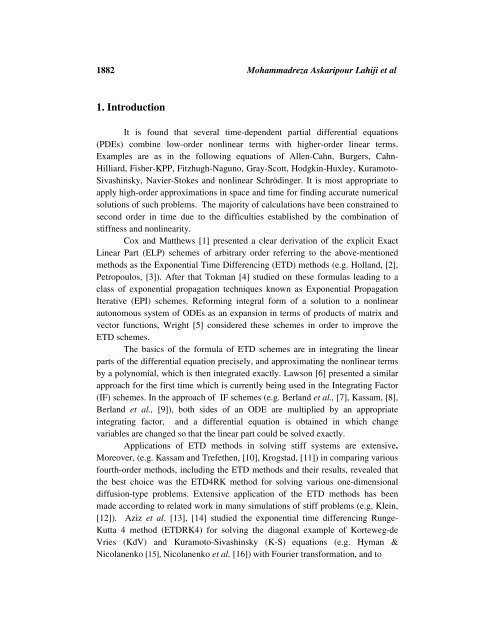A Note on Fourth-Order Time Stepping for Stiff PDE via ... - HIKARI Ltd
A Note on Fourth-Order Time Stepping for Stiff PDE via ... - HIKARI Ltd
A Note on Fourth-Order Time Stepping for Stiff PDE via ... - HIKARI Ltd
You also want an ePaper? Increase the reach of your titles
YUMPU automatically turns print PDFs into web optimized ePapers that Google loves.
1882 Mohammadreza Askaripour Lahiji et al<br />
1. Introducti<strong>on</strong><br />
It is found that several time-dependent partial differential equati<strong>on</strong>s<br />
(<strong>PDE</strong>s) combine low-order n<strong>on</strong>linear terms with higher-order linear terms.<br />
Examples are as in the following equati<strong>on</strong>s of Allen-Cahn, Burgers, Cahn-<br />
Hilliard, Fisher-KPP, Fitzhugh-Naguno, Gray-Scott, Hodgkin-Huxley, Kuramoto-<br />
Sivashinsky, Navier-Stokes and n<strong>on</strong>linear Schrödinger. It is most appropriate to<br />
apply high-order approximati<strong>on</strong>s in space and time <strong>for</strong> finding accurate numerical<br />
soluti<strong>on</strong>s of such problems. The majority of calculati<strong>on</strong>s have been c<strong>on</strong>strained to<br />
sec<strong>on</strong>d order in time due to the difficulties established by the combinati<strong>on</strong> of<br />
stiffness and n<strong>on</strong>linearity.<br />
Cox and Matthews [1] presented a clear derivati<strong>on</strong> of the explicit Exact<br />
Linear Part (ELP) schemes of arbitrary order referring to the above-menti<strong>on</strong>ed<br />
methods as the Exp<strong>on</strong>ential <strong>Time</strong> Differencing (ETD) methods (e.g. Holland, [2],<br />
Petropoulos, [3]). After that Tokman [4] studied <strong>on</strong> these <strong>for</strong>mulas leading to a<br />
class of exp<strong>on</strong>ential propagati<strong>on</strong> techniques known as Exp<strong>on</strong>ential Propagati<strong>on</strong><br />
Iterative (EPI) schemes. Re<strong>for</strong>ming integral <strong>for</strong>m of a soluti<strong>on</strong> to a n<strong>on</strong>linear<br />
aut<strong>on</strong>omous system of ODEs as an expansi<strong>on</strong> in terms of products of matrix and<br />
vector functi<strong>on</strong>s, Wright [5] c<strong>on</strong>sidered these schemes in order to improve the<br />
ETD schemes.<br />
The basics of the <strong>for</strong>mula of ETD schemes are in integrating the linear<br />
parts of the differential equati<strong>on</strong> precisely, and approximating the n<strong>on</strong>linear terms<br />
by a polynomial, which is then integrated exactly. Laws<strong>on</strong> [6] presented a similar<br />
approach <strong>for</strong> the first time which is currently being used in the Integrating Factor<br />
(IF) schemes. In the approach of IF schemes (e.g. Berland et al., [7], Kassam, [8],<br />
Berland et al., [9]), both sides of an ODE are multiplied by an appropriate<br />
integrating factor, and a differential equati<strong>on</strong> is obtained in which change<br />
variables are changed so that the linear part could be solved exactly.<br />
Applicati<strong>on</strong>s of ETD methods in solving stiff systems are extensive.<br />
Moreover, (e.g. Kassam and Trefethen, [10], Krogstad, [11]) in comparing various<br />
fourth-order methods, including the ETD methods and their results, revealed that<br />
the best choice was the ETD4RK method <strong>for</strong> solving various <strong>on</strong>e-dimensi<strong>on</strong>al<br />
diffusi<strong>on</strong>-type problems. Extensive applicati<strong>on</strong> of the ETD methods has been<br />
made according to related work in many simulati<strong>on</strong>s of stiff problems (e.g. Klein,<br />
[12]). Aziz et al. [13], [14] studied the exp<strong>on</strong>ential time differencing Runge-<br />
Kutta 4 method (ETDRK4) <strong>for</strong> solving the diag<strong>on</strong>al example of Korteweg-de<br />
Vries (KdV) and Kuramoto-Sivashinsky (K-S) equati<strong>on</strong>s (e.g. Hyman &<br />
Nicolanenko [15], Nicolanenko et al. [16]) with Fourier trans<strong>for</strong>mati<strong>on</strong>, and to
















